Physical Address
304 North Cardinal St.
Dorchester Center, MA 02124
Abnormalities of the fetal limbs rank as the third most common after those of the cardiac and renal systems according to EUROCAT data (1980–2010).
The most common limb abnormalities amenable to prenatal diagnosis are:
club foot/talipes (9.5 in 10,000 births);
polydactyly (8.9 in 10,000 births);
syndactyly (6.24 in 10,000 births);
limb reduction defects (6 in 10,000 births);
Combine these prevalence figures with:
skeletal dysplasias (1.69 in 10,000 births);
genetic syndromes (4.35 in 10,000 births);
which commonly present with a skeletal anomaly and it becomes evident that these are the principal abnormalities worthy of discussion in this chapter.
Skeletal dysplasias will be considered within the differential diagnosis of their most common presenting ultrasound (US) observation, namely the short femur, with the emphasis on a working model of how to differentiate lethal from non-lethal osteochondrodysplasias and both types of dysplasia from genetic syndromes, aneuploidy and growth restriction. The more commonly encountered skeletal dysplasias will then be considered individually in more detail.
The chapter will cover the more commonly encountered limb abnormalities in turn but the more rare anomalies are beyond the scope of this chapter and reference should be made to clinical geneticist colleagues and online resources in such cases.
Before embarking upon discussion of any abnormality, this chapter will first consider embryology, ultrasound assessment of the normal and abnormal skeleton and the role of other imaging modalities in the assessment of skeletal abnormalities.
Following the diagnosis of a skeletal abnormality the long-term goal of the prenatal diagnostician must be to advise parents on the aetiology and recurrence risks. Knowledge of embryology facilitates this and helps inform the timing of screening tests in any subsequent pregnancy. It assists our interpretation of sonographic observations, as for these to make sense, they should conform to known embryology.
The skeletal system, both the axial and appendicular skeleton, is derived from mesoderm.
The axial skeleton comprises the skull, spine, ribs, sternum and the shoulder and pelvic girdles. The appendicular skeleton comprises the arms and legs. Bone is formed by the condensation of mesenchymal cells followed by ossification in two principal ways, intramembranous and endochondral, with the latter being the more common type. Muscle is formed from the somatic mesoderm.
The normal embryological process may be interrupted or modified for a number of reasons and the gestational age at which the insult occurs determines the type and distribution of the resulting defect.
The earlier the insult the more devastating the effect, hence the most vulnerable period for the developing embryo is before 10 completed weeks from last known period. Examples of teratogens known to produce skeletal abnormality are thalidomide, warfarin, misoprostol, phenytoin and sodium valproate. There have been published reports suggesting a causal link between cocaine or alcohol misuse and limb defects, but this has been difficult to prove in the absence of a clear history of the level of misuse of either drug. A vascular mechanism is proposed for these limb reduction defects and for those caused by early (before 10 weeks’ gestation) chorionic villus sampling. Aside from teratogens and trauma, in its widest sense, faulty genetic instructions are responsible for a number of abnormalities with a skeletal component. Examples of this are mutations in the FGFR3 gene (fibroblast growth factor receptor, chromosome 4) responsible for thanatophoric dysplasia, achondroplasia and hypochondroplasia and mutations in the T-box genes that are linked to Holt–Oram syndrome and Cousin syndrome. As more knowledge is acquired about the genetic component of these disorders the nosology is reviewed and revised regularly, and published with full text available online ( www.isds.ch ).
Table 16-1 attempts to synthesize observations from ‘text-book’ embryology with those made on ultrasound, in particular to marry the embryological event to its equivalent stage in menstrual weeks and the size of the embryo as measured on ultrasound. Please note that as embryological texts refer to conceptual weeks and ultrasound texts to menstrual weeks, these clearly differ by two weeks. All dates referred to here are given in menstrual weeks. Examples are given of the effect of the timing of an insult, or incorrect genetic instruction, on limb development.
| Gestational Age in Menstrual Weeks | CRL (mm) | Skeleton | Limb | Visible on Ultrasound | Defect Caused | Insult |
|---|---|---|---|---|---|---|
| 6th | 3–4 | Mesenchyme | Limb buds appear AER forms |
Amelia | Teratogen Vascular event |
|
| 7th | 5–9 | Mesenchyme | Hand and foot plates develop | Meromelia | Teratogen Vascular event |
|
| 8th | 10–15 | Cartilage | Digital rays develop | Meromelia Syndactyly |
Teratogen Vascular event |
|
| 9th | 16–23 | Ossification begins | Clavicle, mandible and maxilla ossify | Mandible, clavicle | Syndactyly | |
| 10th | 24–32 | Digits distinct Long bones ossify |
Maxilla, humerus, radius, ulna, femur, tibia, fibula, occipital bone | |||
| 11th | 33–42 | Basic fetal template complete; endochondral ossification begins | Terminal phalanges, ilium, scapula, ribs | |||
| 12th | 43–54 | Vertebrae, hand phalanges, metacarpals, | ||||
| 13th | 55–68 | Metatarsals, cranial vault |
In the first trimester, scans can be performed transvaginally and transabdominally. Knowledge of embryology and order of ossification of the entire skeleton is imperative for first-trimester scanning and its correct interpretation.
In the second trimester, transabdominal scanning is performed mainly using a curved array probe but a high-resolution linear probe is also helpful for skeletal assessment giving good views of the spine and cord ( Figure 16-1 ). It is possible to identify all the long bones in each limb, observe their modelling and ossification and to examine the hands and feet: counting the fingers, if not the toes, provided there is a normal amount of amniotic fluid ( Figures 16-2 A–C and 16-3 A–C ). The skull, spine, ribs, shoulder and pelvic girdles are ossified and visible by 20 weeks and thus open to assessment. Fetal movement, range of movement and posture ( Figure 16-4 A and B ) should be observed and a subjective appraisal of muscle bulk made. Measurements of length and circumference may be plotted on published nomograms.
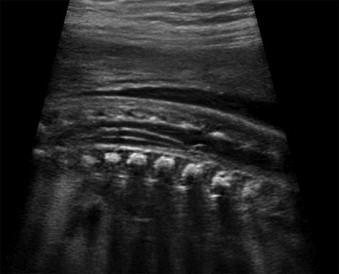
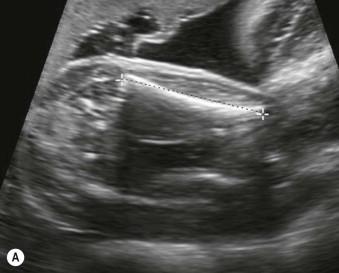
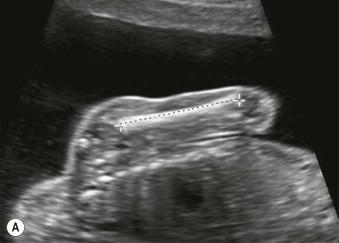
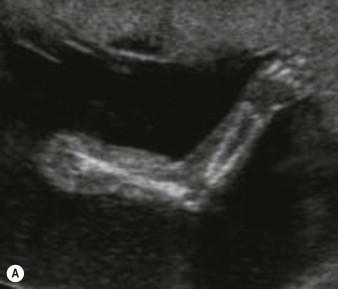
The normal scan is described further in Chapters 1 and 3 .
Pitfalls may arise from ignoring an observation if it is not recognized or understood, thereby ‘editing out’ the abnormality. For example a straight femur may appear angulated scanned from some angles but the converse is not possible, i.e. the observation of a bent/angulated femur is a true one. An angulated femur is an important observation as, even if of normal length, it may indicate a skeletal dysplasia such as campomelia, a syndrome with skeletal manifestations such as Meckel–Gruber syndrome or an isolated abnormality such as proximal femoral focal deficiency (PFFD).
In a tertiary centre a comprehensive assessment is to be expected starting with observation of the posture and movement of the fetus together with estimation of the liquor volume. The sonologist should be alert to any sign of fixed flexion or extension as these can indicate a muscular problem as in arthrogryposis or an abnormality of the brain. Any hydrops or nuchal thickening should be noted.
Evaluation of the appendicular skeleton commences with:
Full biometric measurements of the long bones and the plantar length of the foot.
All four limbs must be individually examined and symmetry checked.
The shape, or modelling, of the long bones is important particularly in cases of abnormal length.
Abnormal modelling might include metaphyseal flaring, diaphyseal irregularity or breakage and abnormal bone density ( Figure 16-5 A–C ).
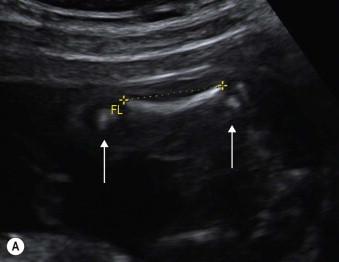
The structure and movement of hands and feet should be examined. Flexion and extension of the fingers should be observed during the scan and the thumb noted to be in a different plane to that of the fingers ( Figure 16-3C ).
The axial skeleton (skull, spine, ribs, sternum, pelvic and shoulder girdles) must be included in the survey:
The skull shape, thickness and ossification is assessed. Its appearance is often a clue to a skeletal abnormality ( Figure 16-6 A–C ). If considered to be thin or underossified, slight compression with the probe with resultant deformation of the vault acts as a confirmatory finding, as does undue clarity of the brain, particularly in the near field.
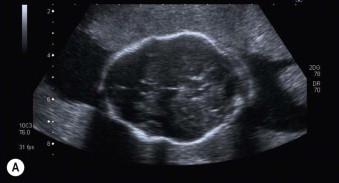
The face and profile should be examined.
The spine will demonstrate ossification of the vertebral bodies and a smooth curve to the spine in the sagittal view.
The normal spinal curves are modified in cases of segmentation abnormality and in some skeletal dysplasias (e.g. achondroplasia).
Platyspondyly is recognized as a feature of some dysplasias and is clearly evident on postnatal radiographs ( Figure 16-7C ). It has poor predictive value as an observation on prenatal ultrasound, particularly if in isolation, due to its subjectivity (compare Figure 16-1 and Figure 16-7A & B ).
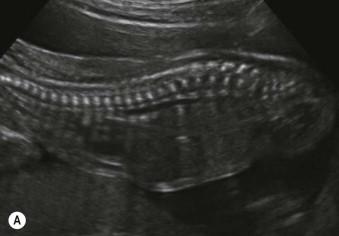
The shoulder girdle can be seen and the measurement of the scapulae and clavicles assessed against nomograms.
The assessment of the pelvis includes the symphysis pubis and the order of ossification of the bones of the pelvis, verification of the presence of the sacral segments of the spine and evaluation of the hip joints.
Finally, the thoracic cage is examined:
Using a split-screen image, without change in image magnification, it is useful to perform a comparison of the cross-sectional areas of the thorax and abdomen to indicate thoracic hypoplasia.
A full-length sagittal view demonstrates marked protuberance of the abdomen providing a sharp angle at the level of the diaphragm anteriorly in thoracic hypoplasia ( Figure 16-8 ).
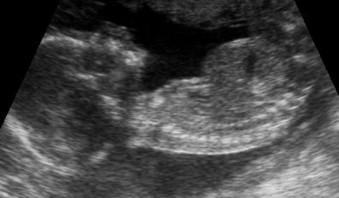
These two observations work well in practice and can be augmented by objective measurements of thoracic circumference or cross-sectional area. This should be followed by an evaluation of rib length; ribs that encompass less than 60% of the thoracic perimeter are considered short ( Figure 16-9 ). Normal ribs are smooth in contour and abnormalities of either ossification or segmentation are well appreciated when viewed obliquely/tangentially. This view allows recognition of rib fusion and fractures ( Figure 16-10 A–C ).
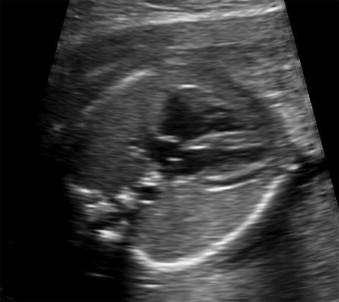
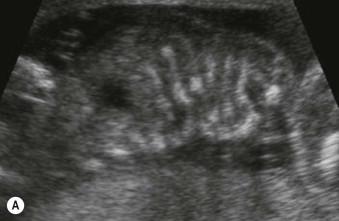
3D and 4D ultrasound have several different modes of display including multiplanar, tomographic, surface rendering and transparent mode, offering flexibility in how the image data are presented. Workers claim an increase over 2D US in diagnostic information of 75.6% in cases of limb anomalies and in skeletal dysplasias. The described advantages being improved visualization of the facial phenotype, ability to evaluate the epiphyses and metaphyses, better appreciation of the relative proportions of the limb segments, and the relative proportions between the trunk and limbs. Three-dimensional ultrasound can be helpful in giving a good pictorial representation of a limb reduction abnormality and 4D ultrasound in the assessment of contractures and movement disorders. It has a valuable role to play in helping parents to understand the appearance of a limb abnormality. This advantage can also be used in a subsequent pregnancy to reassure parents of normality given the visual impact obtained.
The potential for 3D CT is now being explored with the ability to render the fetal skeleton in 3D, stripped of the surrounding maternal bones and soft tissues and of the fetal soft tissues. Workers report improved sensitivity over ultrasound alone citing improved visualization of the skull bones and their ossification, the vertebrae and intervertebral spaces and their relative proportions, the ribs and the pelvic bones. It remains a tool that is complementary to ultrasound not least due to the radiation dose (3.12 mGy) and the need to review and post-process the 350–500 images taken for each case. Published series are of fetuses examined in the third trimester (earliest case: 26 weeks' gestation) which is late to achieve a diagnosis when in the clinical setting a diagnosis or prognostic group is generally sought during the second trimester.
The strengths of iuMRI are that it is multi-planar, displays good soft tissue contrast and it involves no radiation, but is generally inferior to both US and CT in the assessment of bones. Reports indicate that iuMRI has yielded additional information in 48% of cases with anomalies of the upper extremities. IuMRI is good at detecting associated brain anomalies such as the temporal lobe abnormality seen in thanatophoric dysplasia, and for the assessment of lung volume, the spine for dysraphism and the complex pelvic abnormalities seen in caudal regression. Whilst MRI provides information about the fetal skeletal system and other body systems, its exact impact on prenatal management and choices has not been comprehensively quantified. Currently, its use is determined by local availability and whether there is local knowledge in the interpretation of the significance of the iuMRI observations of the fetal skeleton. Its role is discussed further in Chapter 21 .
A short femur is defined as one that lies below the 5th centile or more than three standard deviations (SD) from the mean for gestational age (GA). Published reviews of the outcome following the finding of an isolated short femur indicate that growth restriction is the main significant clinical risk for this group (OR 2.6–3.0 for small for gestational age and 2.6–2.9 for low birthweight). There was no clear link between an isolated short femur and aneuploidy in a population pre-screened with nuchal translucency.
The final diagnosis for fetuses found to have a short femur in association with other anomalies ( complex ) is more varied with two-thirds due to a skeletal dysplasia, aneuploidy or genetic syndrome and one-third with multiple abnormalities for which no final diagnosis was reached. The prognosis for this latter group was poor with no normal survivors in this series.
Ultrasound is reliable at predicting lethality using an FL : AC (abdominal circumference) ratio <0.16 and TC (thoracic circumference) : AC ratio <0.6 as indicators of lethality with accuracies of 96.8%, 99% and 100%. In truth, it is usually a combination of gross and more subtle ultrasound findings that provide this high sensitivity rather than any single ultrasound observation or measurement. Conversely, correct prediction of the skeletal abnormality being non-lethal is achieved in 90%. The correct specific diagnosis is achieved in 65.8–79.3% of cases, with highest correct prediction for thanatophoric dysplasia (88%) and osteogenesis imperfecta type 2 (89%).
In an analysis of 1500 cases of suspected skeletal dysplasia referred to the International Skeletal Dysplasia Registry (ISDR), 83% were confirmed as a skeletal dysplasia, most commonly:
osteogenesis imperfecta type 2 (20%);
thanatophoric dysplasia (11%);
achondrogenesis type 2 (8.2%);
campomelic dysplasia (3.6%).
A further 12% had a genetic syndrome and in 5% no abnormality was confirmed, but it is likely that some of these cases had growth restriction.
The aim of the ultrasound scan is first to identify those fetuses with an abnormality that is lethal or life-limiting or associated with significant morbidity: in these cases termination may be offered. Second is to identify those fetuses for which surveillance during the pregnancy is required, for example those at risk of growth restriction, and those cases for whom a management plan for delivery and neonatal care is necessary because of anticipated neonatal morbidity.
This section offers a method of assessment of the fetus with a short femur which puts the fetus in a group that directs further investigations, counselling of the parents and management decisions, without necessarily having a definite diagnosis before delivery.
In cases where there is isolated short femur, uterine artery Doppler assessment is important, given the link with growth restriction. In addition, serial scans are required to establish a growth curve, as a proportion of these will subsequently prove to be normal. Fetuses with a short femur can be classified into three groups based on the ultrasound findings. In each category there are both lethal and non-lethal conditions, which are tabulated in Table 16-2 .
| Group 1 Isolated Short Femur (SF) |
Group 2 SF Plus Non-Skeletal |
Group 3 SF Plus Skeletal |
|
|---|---|---|---|
| Non-lethal or variable |
Growth restriction Normal |
Ellis–van Creveld syndrome Jarcho–Levin syndrome Chondrodysplasia punctata |
Osteogenesis imperfecta 1, 3 HeZ achondroplasia Jeune's ATD Hypophosphatasia (AD) Cleidocranial dysplasia |
| Non-lethal or variable |
Proximal focal femoral deficiency (PFFD) | Femoral facial syndrome (FFS) | Proximal focal femoral deficiency (PFFD) Femur–fibula–ulna complex (FFUC) |
| * Lethal | Thanatophoric dysplasia (TD) Achondrogenesis SRPS 2 Meckel–Gruber syndrome |
Osteogenesis imperfecta 2 Campomelic dysplasia Jeune's ATD HoZ achondroplasia SRPS 1, 3 & 4 Hypophosphatasia (AR) |
|
| * Lethal | Trisomies 13, 18 Triploidy |
Trisomies 13, 18 Triploidy |
* Death likely in utero or within the first year of life with associated serious morbidity. AD: autosomal dominant; AR: autosomal recessive; ATD: asphyxiating thoracic dystrophy; HeZ: heterozygous; HoZ: homozygous; SRPS: short rib polydactyly syndrome.
This is the group at risk of growth restriction: uterine artery Doppler should be performed at initial assessment and ultrasound surveillance should be instituted to establish growth curves for the biometric measurements. This group is at risk of aneuploidy but, given the introduction of widespread first-trimester screening and of improved sensitivity of ultrasound, the decision regarding amniocentesis will depend on local practice. Other diagnoses in this group include proximal focal femoral deficiency (PFFD) and importantly, a normal outcome.
This group is at risk of aneuploidy and amniocentesis should be considered. The most common chromosomal anomalies are trisomy 18 and triploidy. If euploid, this is the group most likely to have a genetic syndrome with a skeletal component. The prognosis within this group is variable with some diagnoses being compatible with a normal lifespan whilst others are lethal or associated with neurocognitive delay.
Examples of this group are Ellis–van Creveld syndrome, short rib polydactyly syndrome type 2, thanatophoric dysplasia and chondrodysplasia punctata.
This is the group with short femora plus abnormality of the other long bones; frequently there will be abnormality of modelling and of ossification. It is likely that these fetuses will have abnormalities of the hands, feet and ribs (possibly a small thoracic circumference). These are fetuses at the highest risk of having a skeletal dysplasia. If the skeletal abnormalities are clearly evident at 20 weeks and the biometric measurements for the long bones lie well below the 5th centile, it is likely that the fetus has a lethal skeletal dysplasia. Examples of lethal skeletal dysplasias are osteogenesis imperfecta type 2a and the short rib polydactyly syndromes. An example of a non-lethal skeletal dysplasia is heterozygous achondroplasia.
Included in this group are conditions where death is the likely outcome within the first year of life or where the condition is associated with serious disability, mental and/or physical, such that termination of the pregnancy can be discussed. It is never possible to be completely certain of the degree of disability in a survivor due to inherent variations in phenotypic expression. This element of doubt must be carefully explained to, and accepted by, the parents.
Features common to all conditions in this group are profound micromelia with long bone lengths falling more than three standard deviations below the mean for gestation, and a small thorax.
The ‘Big Four’ diagnoses account for some 40–50% of prenatally detected skeletal dysplasias:
Osteogenesis imperfecta type 2.
Thanatophoric dysplasia.
Achondrogenesis.
Campomelic dysplasia.
This is a condition characterized by bone fragility and increased susceptibility to fractures and is caused by gene defects relating to collagen and cartilage synthesis. It has an incidence of between 1 in 10,000 to 20,000 births. Initially classified by Sillence in 1979 into four types this has been extended during the last decade as our understanding of the genetic basis of the conditions has increased. In prenatal diagnosis the aim remains to differentiate the lethal type 2 from the non-lethal types 1, 3 and 4. With experience it should be possible to further differentiate those cases for whom the condition is likely to lead to significant and progressive deformity and morbidity. This is based on the GA at onset and on number and distribution of the fractures seen in the context of any known family history and genetic analysis.
Osteogenesis imperfecta (OI) type 2 is one of the most commonly diagnosed osteochondrodysplasias in utero. On both first- and second-trimester scans, the limb bones are very short, lying well below the fifth centile, broadened and irregular due to the numerous fractures. No normal long bone is seen on the scan. The ribs are irregular due to multiple fractures and the skull vault under-ossified to the extent that it is compressible and allows very clear imaging of the near hemisphere of the brain not normally seen ( Figure 16-6 B ; Figure 16-11 A–D ). The findings are essentially symmetric.
| Type | Inheritance | Gene Defect | US Features | Prognosis |
|---|---|---|---|---|
| OI type 1 | AD | COL1A1 COL1A2 |
Isolated fractures of long bones | Non-lethal Mildest form of OI Hearing impairment in 40–60% |
| OI type 2 | AD, AR | COL1A1 COL1A2 CRTAP LEPRE1 PPIB |
Very short crumpled long bones Rib fractures Poorly or non-ossified calvarium Platyspondyly |
Lethal from respiratory insufficiency and cardiorespiratory failure: 60% within 24 hours 80% within 1 month 100% within 12 months |
| OI type 3 | AD, AR | COL1A1 COL1A2 CRTAP LEPRE1 PPIB FKBP10 SERPINH1 |
Multiple long bone fractures, asymmetric in distribution with little or no reduction in length | Some lethal as neonates Majority survive with progressive deformity Severe scoliosis Thoracic deformity Limb deformity LL≫UL Short stature Use wheelchair Hearing impairment |
| OI type 4 | AD, AR | COL1A1 COL1A2 CRTAP FKBP10 |
Indistinguishable from type 3 antenatally | As type 3 |
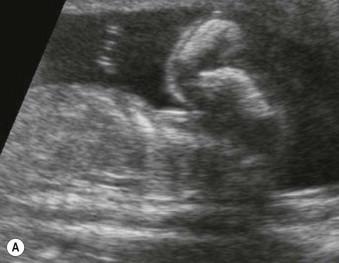
Osteogenesis imperfecta type 1 is often normal on second-trimester scanning with few random asymmetric long bone fractures developing later in the pregnancy.
Osteogenesis imperfecta types 3 and 4 are characterized by multiple asymmetric long bone fractures evident on second-trimester scanning with lower limbs more frequently affected than upper.
Molecular genetics can now offer testing on CVS samples or amniocytes, a process that is facilitated if the gene defect is known from the index case in a family. Greater than 95% of affected individuals have a defect that can be identified on direct genomic analysis of known OI genes, the majority (90%) are heterozygous for variants in the COL1A1 and COL1A2 genes.
Type 2 is lethal with the majority of cases dying within 24 hours of delivery.
Type 1 is compatible with a near-normal existence, with hearing loss a significant development long-term.
Type 3 is progressively disabling with most cases being wheelchair-bound. Life expectancy is reduced due to respiratory complications resulting from the severe kyphoscoliosis and thoracic deformity.
A review of mode of delivery and neonatal outcome in cases of prenatally detected osteogenesis imperfecta showed that Caesarian section did not decrease fracture rates at birth in infants with non-lethal forms and did not prolong survival for those with the lethal form.
This is extremely complex and the input of radiologists, paediatricians, clinical and molecular geneticists and laboratory personnel is required for individual assessment, classification and sound screening strategy, combining ultrasound and DNA testing in any subsequent pregnancy.
Thanatophoric dysplasia (TD) is a lethal form of short-limbed dwarfism caused by abnormal mutations of the Fibroblast Growth Receptor 3 ( FGFR3 ) gene located on the short arm of chromosome 4. It is autosomal dominant and is among the three most common types of lethal skeletal dysplasias having an incidence of 0.2–0.5 : 10,000 births. There are two types, type 1 and type 2, distinguished by the more severe skeletal manifestations of type 1 and the invariable cloverleaf skull abnormalities in type 2. Both types have skeletal and temporal lobe abnormalities that permit prenatal diagnosis with ultrasound, augmented by iuMRI, with confirmation by DNA testing.
Profound micromelia with characteristic bowing (‘telephone receiver’) of the long bones, especially the femora, with metaphyseal flaring ( Figure 16-5 B ; Figure 16-12 A–D ).
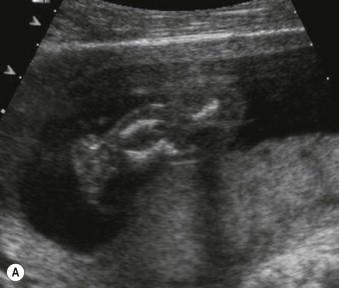
The hands are stubby with short fingers.
The ribs are very short with resultant thoracic hypoplasia leading to a protuberant abdomen.
There is platyspondyly ( Figure 16-7A ).
The skull may be of abnormal cloverleaf shape with underlying megalencephaly of the temporal lobes with abnormal and deep transverse sulci detectable on both US and MRI ( Figure 16-6A ).
Polyhydramnios is frequent.
Additional findings, evident on X-ray but not readily observed on prenatal US, are small pelvic bones, flat acetabular roofs, and facial abnormalities: frontal bossing, prominent eyes and a depressed nasal ridge.
A lesser degree of micromelia and does not show the characteristic curved deformity of the long bones.
Hypoplasia of the thorax and shortening of the ribs.
Fetuses invariably have the cloverleaf skull deformity and temporal lobe abnormality.
DNA testing is possible in the first trimester to identify the abnormal mutations of FGFR3 . Reports suggest potential for non-invasive testing using cell free fetal DNA (cffDNA) which, if shown to be consistently accurate and to be freely available, would obviate the need for post-termination investigations including radiology and permit first-trimester termination using surgical techniques.
Both types of TD are lethal due to pulmonary hypoplasia either in utero or the neonatal period.
This is an autosomal dominant condition arising from a new mutation and has no increased risk of recurrence in a subsequent pregnancy. The condition is, however, amenable to first-trimester diagnosis either with US or with DNA testing, depending on parental preference, should reassurance be sought in a subsequent pregnancy.
Achondrogenesis has an incidence of 0.25 : 10,000 births. There are three forms, types IA, IB and II, distinguished by the greater severity of limb shortening and the presence of rib fractures in type I. Type I occurs due to abnormalities on chromosomes 14 and 5 for types IA and IB respectively, and both are autosomal recessive. Type II occurs due to an abnormality of the type II collagen gene ( COL2A1 ) on chromosome 12 and is autosomal dominant. Type II is the type most commonly encountered in clinical practice.
Become a Clinical Tree membership for Full access and enjoy Unlimited articles
If you are a member. Log in here